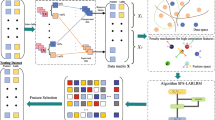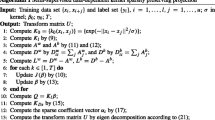Abstract
With the rapid growth of high dimensional data, dimensionality reduction is playing a more and more important role in practical data processing and analysing tasks. This paper studies semi-supervised dimensionality reduction using pairwise constraints. In this setting, domain knowledge is given in the form of pairwise constraints, which specifies whether a pair of instances belong to the same class (must-link constraint) or different classes (cannot-link constraint). In this paper, a novel semi-supervised dimensionality reduction method called adaptive semi-supervised dimensionality reduction (ASSDR) is proposed, which can get the optimized low dimensional representation of the original data by adaptively adjusting the weights of the pairwise constraints and simultaneously optimizing the graph construction. Experiments on UCI classification and image recognition show that ASSDR is superior to many existing dimensionality reduction methods.











Similar content being viewed by others
References
Duda RO, Hart PE, Stork DG (2001) Pattern classification, 2nd edn. Wiley, New York
Jolliffe IT (2002) Principal component analysis, 2nd edn. Wiley, New York
Sharma A, Paliwal KK, Imoto S, Miyano S (2013) Principal component analysis using QR decomposition. Int J Mach Learn Cybern (IJMLC) 4:679–683
Sharma A, Paliwal KK (2015) Linear discriminant analysis for the small sample size problem: an overview. Int J Mach Learn Cybern (IJMLC) 6:443–454
Chapelle O, Schölkopf B, Zien A (2006) Semi-supervised learning. MIT Press, Cambridge
Song Y, Nie F, Zhang C, Xiang S (2008) A unified framework for semi-supervised dimensionality reduction. Pattern Recognit 41(9):2789–2799
Chatpatanasiri R, Kijsirikul B (2010) A unified semi-supervised dimensionality reduction framework for manifold learning. Neurocomputing 73(10–12):1631–1640
Alok AK, Saha S, Ekbal A (2015) Semi-supervised clustering for gene-expression data in multiobjective optimization framework. Int J Mach Learn Cybern (IJMLC). doi:10.1007/s13042-015-0335-8
Wagstaff K, Cardie C (2000) Clustering with instance-level constraints. In: Proceedings of the 17th International Conference on Machine Learning, pp 1003–1110
Chen C, Zhang J, He X, Zhou ZH (2012) Non-parametric kernel learning with robust pairwise constraints. Int J Mach Learn Cybern (IJMLC) 3:83–96
Klein D, Kamvar SD, Manning CD (2002) From instance-level constraints to space-level constraints: making the most of prior knowledge in data clustering. In: Proceedings of the 19th International Conference on Machine Learning, pp 307–314
Bar-Hillel A, Hertz T, Shental N, Weinshall D (2005) Learning a mahalanobis metric from equivalence constraints. J Mach Learn Res 6:937–965
Xing EP, Ng AY, Jordan MI, Russell S (2003) Distance metric learning, with application to clustering with side-information. Adv Neural Inf Process Syst 15:505–512
Tang W, Zhong S (2006) Pairwise constraints-guided dimensionality reduction. In: Proceedings of the SDM’06 Workshop on Feature Selection for Data Mining, pp 59–66
Yeung DY, Chang H (2006) Extending the relevant component analysis algorithm for metric learning using both positive and negative equivalence constraints. Pattern Recognit 39(5):1007–1010
An S, Liu W, Venkatesh S (2008) Exploiting side information in locality preserving projection. In: Proceedings of the 2008 IEEE Conference on Computer Vision and Pattern Recognition, pp 1–8
Zhang D, Zhou Z, Chen S (2007) Semi-supervised dimensionality reduction. In: Proceedings of the 7th SIAM International Conference on Data Mining, pp 629–634
Chen S, Zhang D (2011) Semisupervised dimensionality reduction with pairwise constraints for hyperspectral image classification. IEEE Geosci Remote Sens Lett 8(2):369–373
Cevikalp H, Verbeek J, Jurie F, Klaser A (2008) Semi-supervised dimensionality reduction using pairwise equivalence constraints. In: Proceedings of the 2008 International Conference on Computer Vision Theory and Applications, pp 489–496
He X, Niyogi P (2004) Locality preserving projections. Adv in Neural Inf Process Syst 16:153–160
Wei J, Peng H (2008) Neighborhood preserving based semi-supervised dimensionality reduction. Electron Lett 44(20):1190–1191
Roweis ST, Saul LK (2000) Nonlinear dimensionality reduction by locally linear embedding. Science 290(5500):2323–2327
Baghshah MS, Shouraki SB (2009) Semi-supervised metric learning using pairwise constraints. In: Proceedings of the 21st International Joint Conference on Artificial Intelligence, pp 1217–1222
Davidson I (2009) Knowledge driven dimension reduction for clustering. In: Proceedings of the 21st International Joint Conference on Artificial Intelligence, pp 1034–1039
Yan S, Bouaziz S, Lee D, Barlow J (2012) Semi-supervised dimensionality reduction for analyzing high-dimensional data with constraints. Neurocomputing 76(1):114–124
Belkin M, Niyogi P (2003) Laplacian eigenmaps for dimensionality reduction and data representation. Neural Comput 15(6):1373–1396
Chapelle O, Zien A (2005) Semi-supervised classification by low density separation. In: Proceedings of the 22nd International Conference on Machine Learning, pp 57–64
Sim T, Barker S, Bsat M (2003) The CMU pose, illumination, and expression database. IEEE Trans Pattern Anal Mach Intell 25(12):1615–1618
Georghiades AS, Belhumeur PN, Kriegman DJ (2001) From few to many: illumination cone models for face recognition under variable lighting and pose. IEEE Trans Pattern Anal Mach Intell 23(6):643–660
LeCun Y, Bottou L, Bengio Y, Haffner P (1998) Gradient-based learning applied to document recognition. Proc IEEE 86(11):2278–2324
Zhang D, Kong W, You J, Wong M (2003) Online palmprint identification. IEEE Trans Pattern Anal Mach Intell 25(9):1041–1050
Acknowledgments
This work is supported by the National Natural Science Foundation of China (61402181, 61273363), the Science and Technology Programme of Guangzhou Municipal Government (2014J4100006), the Guangdong Natural Science Foundation (S2012040008022, S2012010009961).
Author information
Authors and Affiliations
Corresponding author
Rights and permissions
About this article
Cite this article
Meng, M., Wei, J., Wang, J. et al. Adaptive semi-supervised dimensionality reduction based on pairwise constraints weighting and graph optimizing. Int. J. Mach. Learn. & Cyber. 8, 793–805 (2017). https://doi.org/10.1007/s13042-015-0380-3
Received:
Accepted:
Published:
Issue Date:
DOI: https://doi.org/10.1007/s13042-015-0380-3




